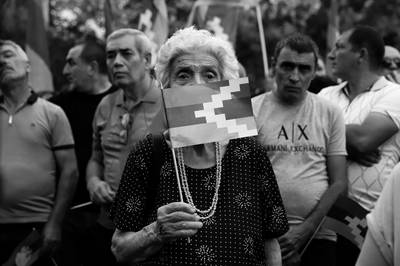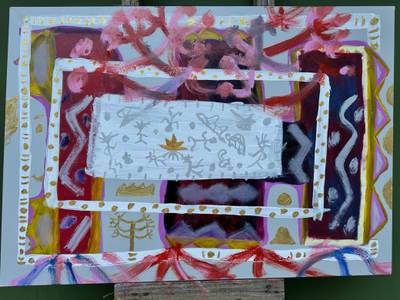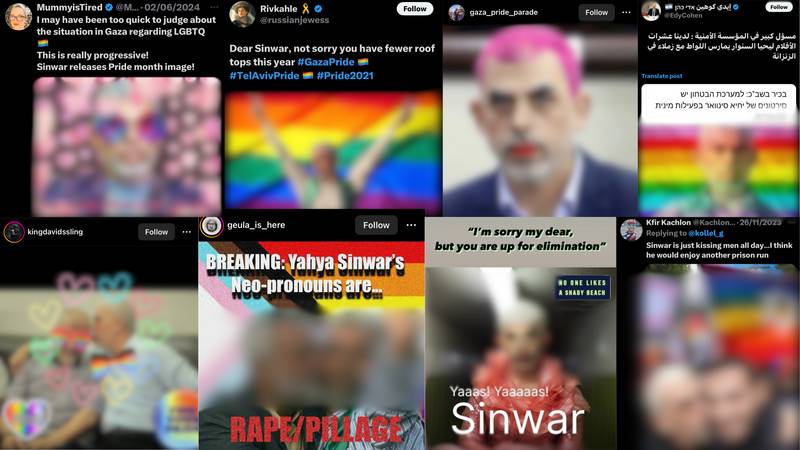

Screenshots taken from various Israeli accounts posting photoshopped pictures of Yahya Sinwar, head of Hamas in the Gaza Strip, portraying him (and other resistance leaders) as (trans) women or homosexual. Images have been blurred out of respect for the Palestinian resistance.
Musa Shadeedi is an Iraqi queer writer and researcher specialising in using an Islamic anti-colonial approach to study sexual desire in the history and politics of the “Middle East”.
Since the operation Al-Aqsa Flood on October 7, the pro-Zionist group’s obsession with Hamas leaders has intensified, often taking on a highly sexualised form. Israeli LGBT Instagram accounts, influencers on X, and Telegram channels began sharing photoshopped images of Yahya Sinwar, the head of Hamas in the Gaza Strip, depicting him and other resistance leaders as trans women or homosexual. Over time, this practice became a widespread phenomenon in Israel.
Some of the images depicted Sinwar with rainbow flags, while others showed him hugging or kissing other Hamas leaders, such as Ahmed al-Ghandour, and Ismail Haniyeh—both of whom were assassinated by IOF during the genocide. These images were altered with rainbow colours and accompanied by sarcastic remarks suggesting a sexual relationship between them. For example, one prominent Israeli feminist wrote the marriage equality slogan “Love is Love” on a picture of Ismail Haniyeh kissing Sinwar’s cheek.
AI was also used to create drag/queer versions of Sinwar, which appeared on many Israeli accounts across the internet. One such image featured Sinwar wearing makeup, lipstick, and pink-dyed hair. It was first published on October 28th, the night of Sinwar’s birthday, on an Israeli Telegram channel and was later shared by dozens of Israeli/Zionist pages and accounts. Another image, published by Queers for Israel, a gay Israeli account founded on October 14th, portrayed Sinwar as a drag queen with the caption, “I’m sorry dear, but you are up for elimination.”
In February, the Israeli news platform The Jerusalem Post published a scandalous article accusing Sinwar of keeping “silicon accessories and toys in his cell” while he was at Ashkelon prison and of “sexually harassing” male prisoners.1 A month later, Eyllon Levy, a British-Israeli who served as the official Israeli government spokesman during the genocide, asked Daniel Spaulding, a prominent Zionist gay figure in the West, on his show Israel State of a Nation, if he would date Yahya Sinwar, Ismail Haniyeh, or other resistance leaders. He then asked Spaulding to classify them with gay sexual terms like “silver daddy” and “polar bear.”2 Suddenly, the sexuality of these leaders became part of Israeli war discussions.
Right before his assassination, some accounts began posting AI-generated images of Sinwar wearing a burqa, with captions suggesting that he was hiding in women’s clothing from Israeli soldiers. The pro-Israel accounts spared no Orientalist imagery in their depictions of Sinwar. Even when portraying him as a woman, he was cast either as the “oppressed” veiled woman trying to escape from soldiers or as the lusty Oriental figure in other images. All the accompanying comments on these depictions were linked to Islam.
After his assassination, someone shared a video of him hugging and kissing Ismail Haniyeh, accompanied by the caption, “Allah punished Yahya Sinwar for being gay.” Another caption, placed over the image of his corpse released by the Israelis, read, “72 queer virgins await Sinwar…”
Western media employed similar tactics against Yasser Arafat, the leader of the PLO, after Israeli channels broadcast clips of him giving Atallah Hanna the Socialist fraternal kiss. These broadcasts were used to accuse him of homosexuality. In 2007, Out magazine, an American LGBT publication, published an article titled Was Arafat Gay?, in which they referred to him as a “homosexual terrorist.”3
The article claimed that HIV/AIDS was the cause of his death, a rumour originally spread by a former Romanian intelligence officer linked to right-wing, neoconservative groups. However, French medical records and two Tunisian doctors who treated Arafat confirmed that his HIV blood tests were negative shortly before his death. Despite this, the article used the rumor to imply his homosexuality, framing his death as a result of his sexuality rather than an Israeli assassination, effectively justifying it.4
Recently, some pro-Israeli accounts reshared pictures of Arafat’s kisses following the events of October 7. This is despite the fact that Arafat was Hamas’s non-Islamic rival in Palestinian domestic politics.


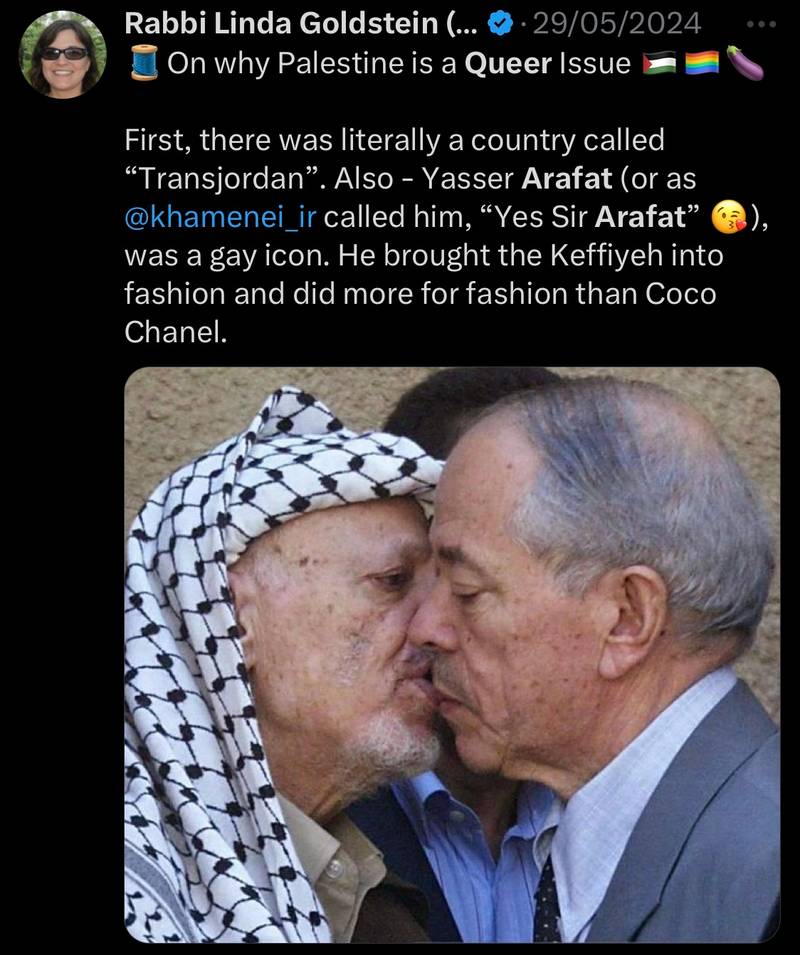



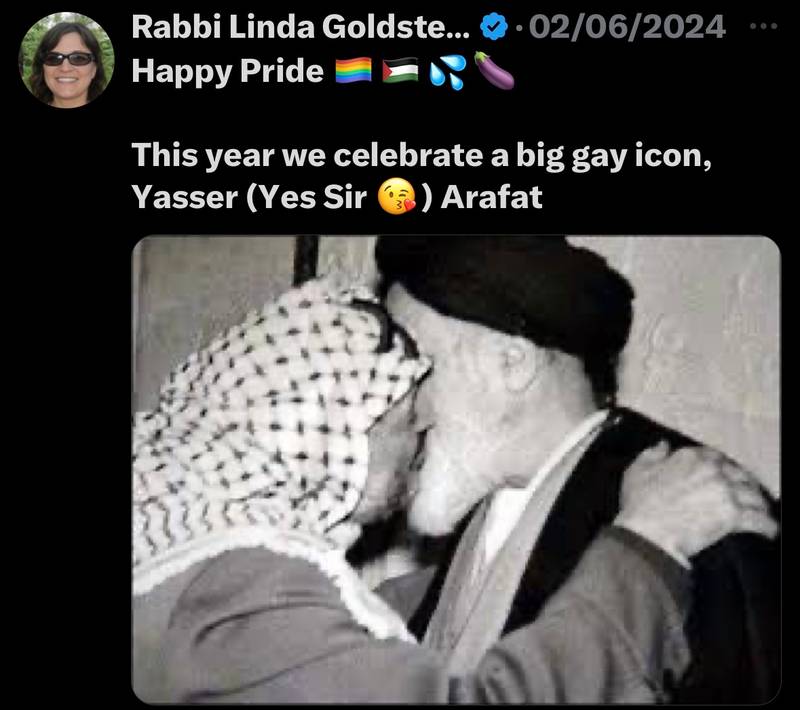

The West has deployed similar tactics outside Palestine in its imperial wars. For instance, the CIA considered creating a fake video of Saddam Hussein engaging in a sex act with a teenage boy to destabilize his regime before the U.S.-led invasion in 2003.5 The use of the word “gay” as an insult was documented in Abu Ghraib prison in Iraq. According to the Taguba Report: “[US soldiers] called them [the prisoners] all kinds of names such as ‘gays,’ asking if they liked to make love to guys.”6 This practice of queering the enemy as a form of humiliation had already occurred in the U.S. military prior to this incident. In October 2001, during the United States’ invasion of Afghanistan, a message was written on a bomb by an unidentified U.S. Navy sailor: “HIGH JACK THIS FAGS.” The phrase “HIGH JACK” referenced the September 11 attacks a month earlier, which involved the hijacking of passenger airplanes.
Similarly, The American Globe Magazine also contributed to this narrative by publishing an article on May 30, 2011 (the same month as Osama bin Laden’s assassination) titled Bin Laden Was Gay. These instances reflect a broader pattern of queering/feminising Muslims by the West throughout history to justify aggression.7
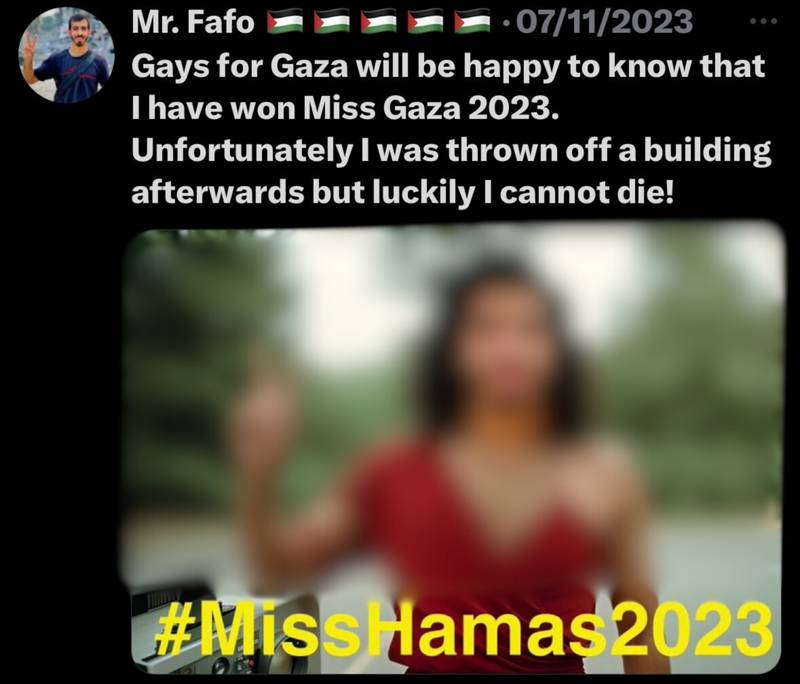







Zionist pages didn’t stop at targeting Yahya Sinwar and the leaders of Hamas. They also went after Gazan journalist, YouTuber, and singer Saleh Al-Jafrawi, who has documented numerous Israeli crimes and massacres in Gaza. The Zionists created a parody account similar to the one they made for Sinwar, named “Mr. Fafo.” Using AI, they superimposed his face onto images of women’s bodies. Additionally, the account posted several tweets suggesting a queer relationship between him and Sinwar, such as: “I am now in Qatar to see my husband, Yahya Sinwar. We are very gay and in love.”
Zionist cartoonist Itzik Samuel also contributed with caricatures. In one, Hamas fighters are depicted wearing maid outfits, vacuuming up humanitarian aid into a tank labelled “Hamas.” In another, a fighter is shown attempting to launch a drooping, flaccid rocket while swallowing large amounts of Viagra, symbolising “sexual impotence.” Another portrays a resistance fighter as a drag queen in a nurse costume.
The artist didn’t limit himself to Al-Qassam fighters. One cartoon features two versions of the same fighter: the first is a rugged-looking man wearing a shirt, trousers, and a turban, carrying a rocket launcher, with the word “Houthi” (the Yemeni resistance) written above in Hebrew. To the left stands the second version—identical but nude, with makeup, long eyelashes, and seductive facial features. He turns his back, revealing a G-string, with the word “Houthini” written above, playing on the Hebrew word for women’s lingerie.






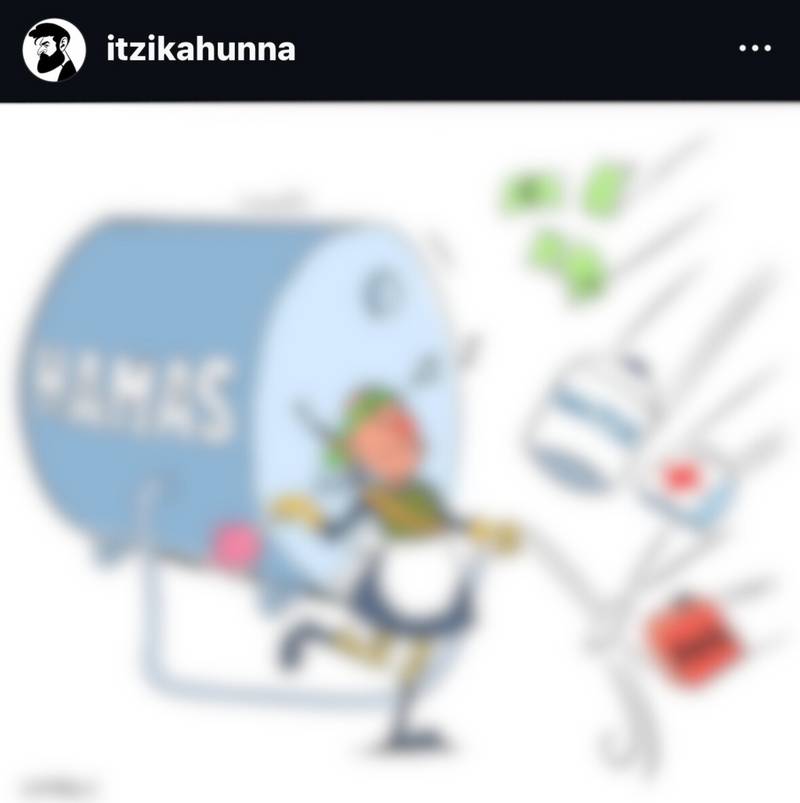

What’s striking is that this portrayal of fighters as sexually impotent contradicts Israel’s simultaneous hyper-masculinisation of Hamas fighters—particularly the now widely discredited8 claims that they committed mass rapes on October 7th. This allegation, heavily promoted by Israel and Western Zionist media, was used to justify the ongoing genocide. By maintaining this contradiction, they echo the rhetoric of their Crusader predecessors, who similarly accused Muslims of both hypersexual aggression and sexual deviance, as previously discussed.
The Zionist project: an extension of the Western colonial crusade
Historically, sexual arguments have been used as a tool to justify aggression against Muslims since the First Crusade. In many early Crusade histories, a letter found before 1098 justified the occupation of the Holy Land on the pretext of purifying it from the “sin of sodomy.” After describing sexual atrocities against Christian women, the letter recounts the same-sex “crimes” committed by Muslims: “But what next? We move on to worse things. Men of every age and rank… have been degraded by the sin of sodomy.”9
The Council of Nablus was held in the Crusader Kingdom of Jerusalem on January 16, 1120. Canon 8 mandated the stake burning of an adult sodomite, including both the active and passive parties (tam faciens quam paciens). Canon 12 stated that a man who willingly had sexual relations with a Muslim woman should be castrated, while she would have her nose mutilated. Criminalising both acts concurrently suggests a deliberate link between them.10
According to Mark Steckler, “By the time of the Fifth Crusade (1217–1221), the association between sodomy and Islam had become almost matter-of-fact in Christian writings on the Middle East.” In his article, “Brotherhood of Vice: Sodomy, Islam, and the Knights Templar,” he cites William of Ada’s De Modo Sarracenos Extirpandi (13th century), which described Muslims—referred to as Saracens—engaging in various sexual acts. It states, “They have effeminate men in great number,” who dressed and acted as women, and that “men with men working that which is unseemly… Saracens, oblivious of human dignity, freely resort to these effeminates and live with them as among us men and women live together openly.” Such claims were used to justify launching another crusade against them.
This tactic evolved further during the colonial era, when Orientalists expressed disgust at Muslim sexual practices in general and same-sex practices in particular. For example, Thomas Herbert, the English ambassador to the court of Shah Abbas in Persia from 1626 to 1629, was horrified by the elaborate costuming and feminine artifice that, to his eyes, marked the wine-bearing boy servants in the court as effeminate and repugnant. He described them as wearing “vests of gold, rich bespangled turbans and embroidered sandals, curled hair dangling about their shoulders, rolling eyes, and vermilion cheeks.”11
Charles Sonnini, a former engineer in the French navy, complained in a late 18th-century travelogue: “The passion contrary to nature […] constitutes the delight, or, to use a juster term, the infamy of the Egyptians. […] This horrid depravity, which, to the disgrace of polished nations, is not altogether unknown to them, is generally diffused over Egypt: the rich and the poor are equally infected with it.”12
The orientalists targeted all forms of cultural production that didn’t align with the Western heteronormativity and patriarchal gender binary. John Hindley, in the preface to his 1800 translation of Persian poetry, informs English readers that the “disgusting object[s]” of these love poems has been feminised, stating that the reasons for this choice are "too obvious to require any formal apology."13 Antoine Clot (Clot Bey), a French physician who served as the surgeon-in-chief of the Egyptian army, the Pasha’s chief surgeon, and the founder of Qasr El Eyni Hospital—the first modern medical school in Arabic-speaking countries—also expressed strong opinions on cultural practices. He attacked belly dancing, stating, "The nature of their [Eastern dancers’] dancing is so licentious that I will neither venture to describe the details nor speak of it in general terms."14
When Egypt banned female dancers from performing in public, Clot Bey went on to criticise the rise of Khawalat (male dancers in female clothing). He complained, "Since female dancers were prohibited from performing in public, the number of these effeminate male dancers reached shameful levels, replacing one form of corruption with a more heinous one. I call upon the Egyptian government to uproot without delay this disgrace that defiles the Egyptian soil."15
The Zionist project, as an extension of the Western colonial crusade, has employed similar tactics. Israeli researcher Ofri Ilani, in his paper, An Oriental Vice: Representations of Sodomy in Early Zionist Discourse, traced Hebrew academic, medical, criminal, and ethnographic literature printed in Palestine before the establishment of the Zionist colony. He presented several examples, such as German-born pedagogue and criminologist Carl Frankenstein of the Hebrew University, who discussed Arab sexuality in his 1947 book Youth Neglect. Frankenstein identified a “sodomitic tendency” in Nablus, claiming that “homosexual offences are fairly commonplace” and that “sexual offences are more prevalent with oriental youths, in particular neglected ones, than with European youths.”16 Consequently, the Zionist Hebrew press used the “threat of sodomy as propaganda against socialising with Arabs and for ethnic separation”,17 reinforcing apartheid.
An early instance of this justification for killing Palestinians by Israelis occurred in 1937 when Hungarian-Israeli police officer Mordechai Schwartz fatally shot his Palestinian colleague Mustafa Khoury in the British Mandate Police. The newspaper Iton Meyuchad attempted to frame the murder as an act of self-defence, claiming Khoury had tried to sleep with Schwartz. This narrative sought not only to absolve Schwartz but also to dehumanise the victim, setting a disturbing precedent for excusing violence against Arabs by accusing them of homosexuality.18
The Zionist queering and feminisation of Muslim resistance fighters drive hatred against homosexuality in Muslim Arab societies. By establishing homosexuality or femininity as a colonial insult or accusation directed at the heroes of their resistance, its effect is no different from what was documented by the British Orientalist and Africa scholar Richard F. Burton (1821–1890): “In the present age, extensive intercourse with Europeans has produced not a reformation but a certain reticence amongst the upper classes: they are as vicious as ever, but they do not care for displaying their vices to the eyes of mocking strangers.”19


Translation: “The righteous woman is the honourable one who cares about the well-being of her home and children, serving as a good role model for them. On the other hand, the corrupt and dishonourable woman does not care about that, behaving savagely in a manner unrelated to femininity, indifferent to society’s contempt for her.”
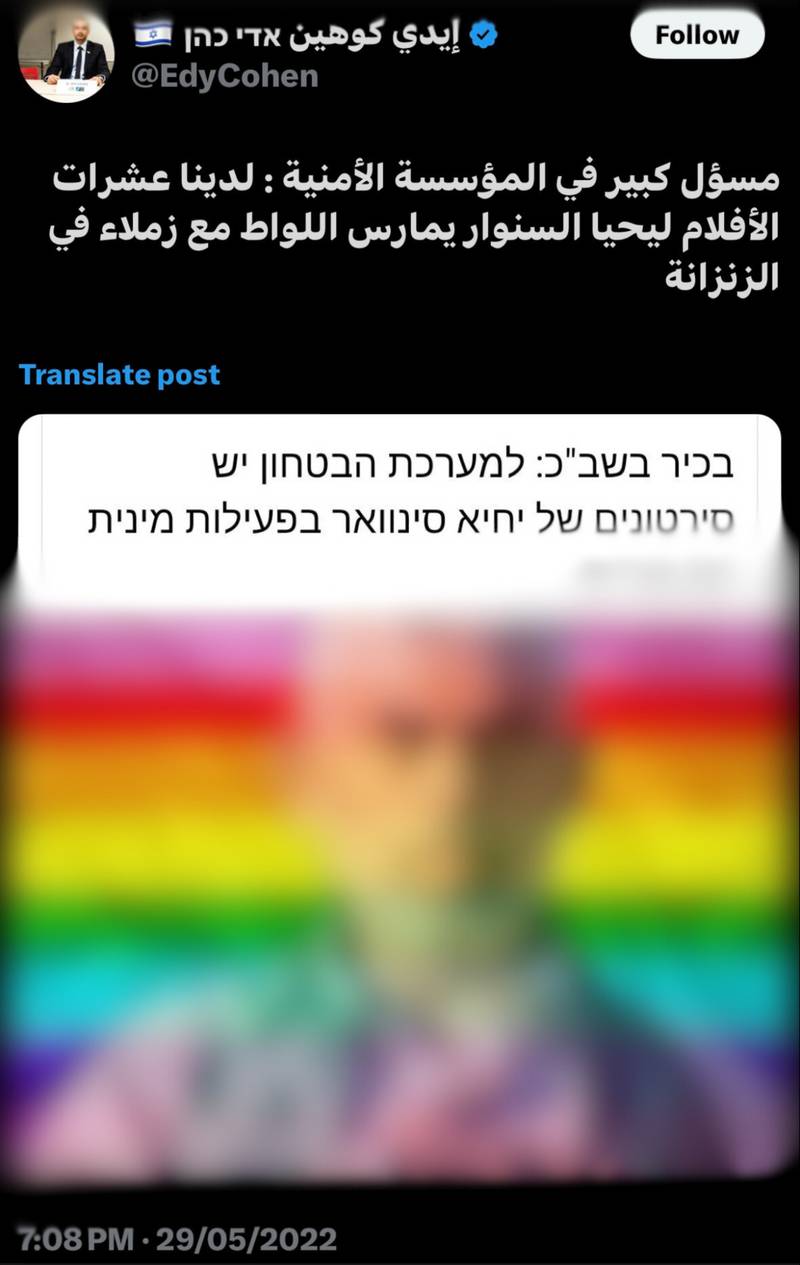

Translation: A senior official in the security establishment: “We have dozens of videos of Yahya Al-Sinwar engaging in sodomy with fellow inmates in prison.”
Afsaneh Najmabadi documented a similar effect on Iranian society: “In the nineteenth century, Iranians became acutely aware that adult man–amrad love and sexual practices prevalent in Iran were considered vices by Europeans. As ‘another gaze’ entered the scene of desire, Iranian men interacting with Europeans in Iran or abroad became highly sensitised to the idea that their desire was now under European scrutiny.”20
That’s one of the major reasons why Muslims and Arabs began hiding their sodomy after the Orientalist era, whereas before, they did not—like Al-Wathiq, the ninth Abbasid caliph who (r. 842 to 847), was in love with Muhaj. He wrote a love poem to him:
Muhaj owns hearts with a glance so deep,
Graceful form, slender sweep.
Full of charm, with a playful art,
No gaze can from him depart.21
Many other Muslims from different backgrounds and social classes openly engaged in same-sex relationships until the colonial project reached Muslim/Arab societies and spread Western queerphobia.
The Israeli army, as an extension of Western Orientalism/colonialism, has publicly promoted queerphobia and patriarchy. For example, in 2018, Avichay Adraee, the Arabic-language spokesperson for the Israeli army, posted a statement shaming Palestinian women protesting at Gaza’s borders, saying, “The corrupt and dishonourable woman… behaving savagely in a manner that has nothing to do with femininity, indifferent to society’s contemptuous view of her.” He was inciting Muslim society to oppress both queerness and femininity in Arabic. While Edy Cohen, an Israeli journalist fluent in Arabic and one of the most followed Israeli accounts among Arabs, published a report in 2022 claiming that Israeli security possesses sodomy videos of Sinwar, addressing his audience in Arabic. Cohen’s goal was certainly not to increase acceptance of homosexuality in Arabic-speaking societies, but to reinforce its use as a stigma and disgrace.
This allowed the colonial West to accuse Muslims of this hatred in their propaganda, turning it into fuel for sustaining their pinkwashing22 policies. So they are amplifying the stigma on queerness to sustain its weaponization’s effect against leaders and resistance fighters.
This is why Abd El-Wahab El-Messiri, a prominent Egyptian scholar of Zionism and Judaism, argued that “sexual patterns in Western civilisation have nothing to do with sex; therefore, it cannot be explained in isolation from the Western cognitive dimension.” This illustrates how sexualisation frequently serves as a tool for deeper cultural and political goals.
This pattern of feminising/queering Muslims to justify assassinating/genociding them parallels the feminising/queering of their land, portraying it as a “virgin land” with no people in colonial discourse, excited to be occupied/raped.
If we understand Orientalism as a project aimed at creating the West and Western identity in opposition to Islam, then it requires feminising Muslims to define Western masculinity while simultaneously hyper-masculinising Muslims to create a feminist/queer-friendly West. In this way, Muslims inhabit what Massad calls a “hermaphroditic existence.”23
Weaponizing Queerness
To dehumanise their enemies, Israel weaponises queerness and femininity as insults to justify assassinations, portraying its targets as queer or trans women. This starkly contrasts with Israel’s self-promotion as a “Gay Heaven” to the West, a narrative cultivated through pinkwashing since 2010. For example, in 2011, Netanyahu addressed the U.S. Congress, claiming that Israel stood apart in a region where “women are stoned, gays are hanged, and Christians are persecuted”, repeatedly seeking Western support by touting his supposed respect for queers and women. This blatant contradiction underscores the hypocrisy at the core of their narrative.24
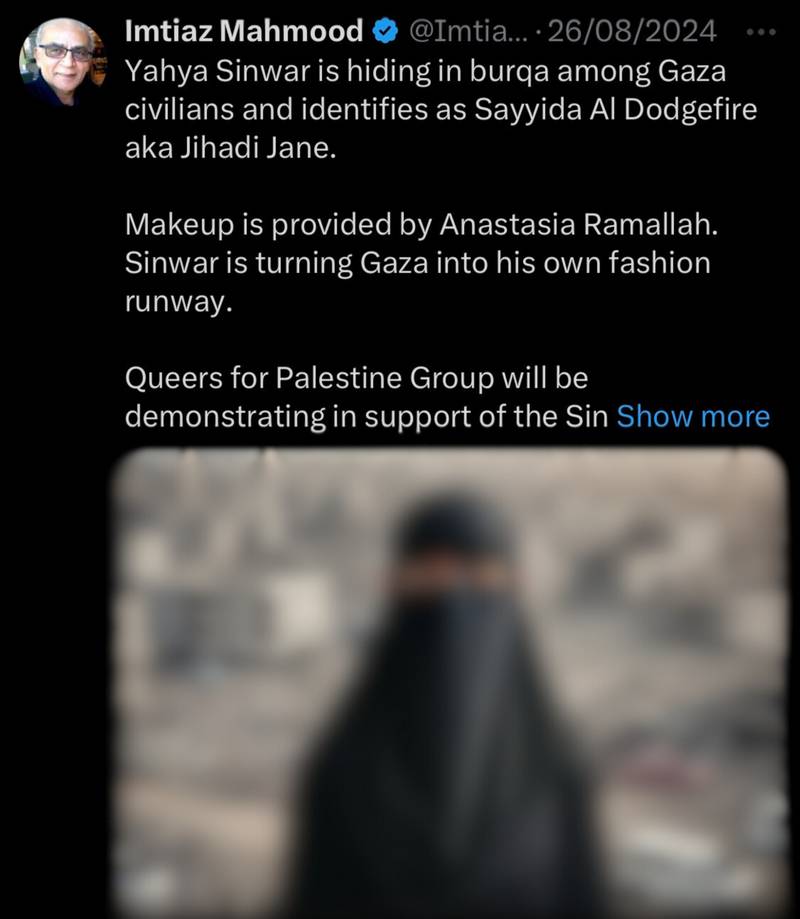

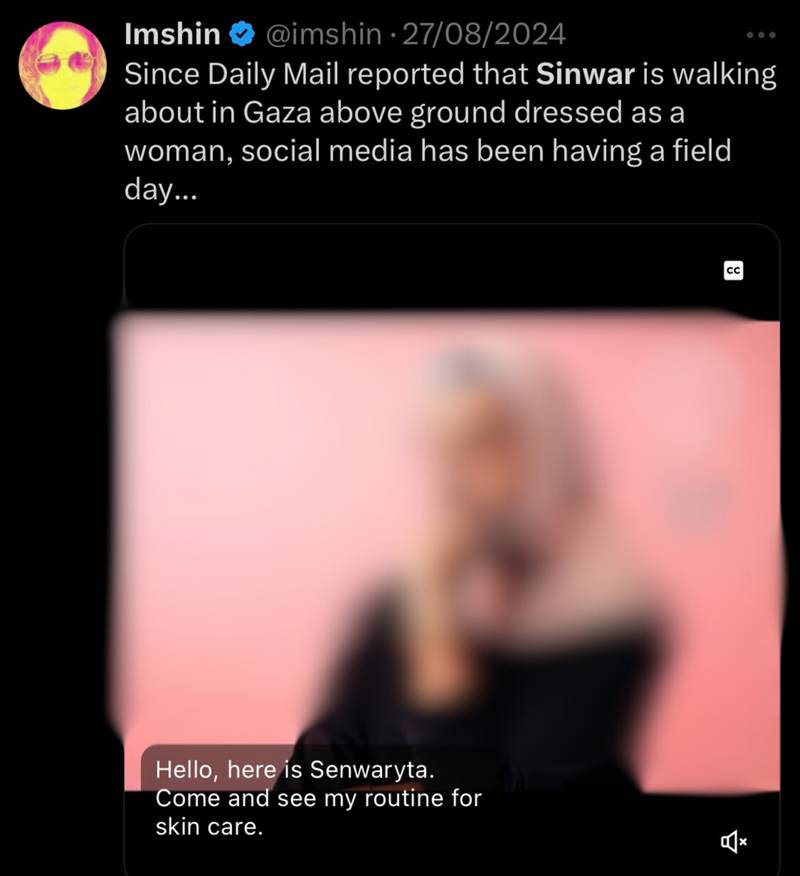





These photos expose the contradiction in Israel’s fabricated narrative, which painted him as queer-phobic and accused him of torturing gay people in Gaza in order to win the support of Western LGBT groups for Israel’s wars on Gaza. Now, ironically, Sinwar is suddenly labelled as queer himself.
Using sexualised arguments to justify genocide and political assassinations is a disturbing element of both historical and modern Western colonialism. The rainbow flags surrounding Sinwar, intended to mock and humiliate him and Hamas, underscore this issue. The involvement of media figures and influencers in spreading these images further amplifies their impact, making it a widespread tactic among Israeli supporters. By using well-known LGBTQ+ symbols, they not only target Sinwar but also attempt to shame queer individuals who support Palestine worldwide. This behaviour exposes a Freudian regression, revealing the Islamophobic, white supremacist, and queerphobic nature of the project—a contradiction that can’t be resolved, signalling a colony on the brink of collapse.


